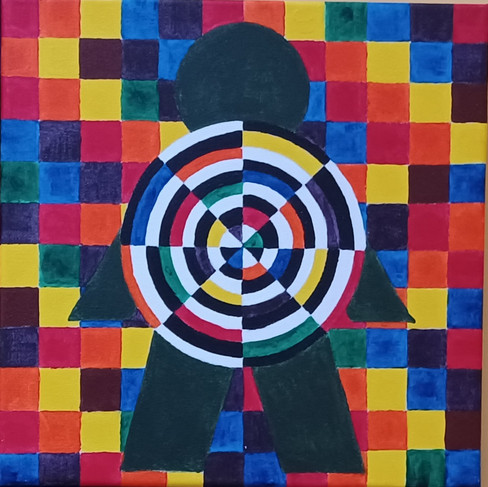Days of Worry
- KDL

- Nov 1, 2024
- 5 min read
Updated: Dec 12, 2024
second in series on Anxiety
I hope you've already had a chance to read This is Calm. If not, head over to that post before reading today's post.
It might seem strange to begin a series on anxiety by talking about what Calm is, but the long term goal of conquering anxiety is to be able to return to Calm quickly when stressors happen. Life is stressful. That's a fact. You might look around at public figures or acquaintances and think their life is smooth sailing, but I guarantee you they have worries, too. Their stressors may look completely different than yours, and they may hide it better, but everyone has things that get them churning.
Worried (L) and Calm (R), both 12 x 12 acrylic on canvas by Kimberly Lavoie
In my painting series I represented the state of worry with another image of a figure in front of a colorful background. In order to understand the symbolism of this painting, it's best to compare "Worried" and "Calm" side-by-side. First, notice that the figure is a darker -- browner -- shade of green. The worried person is not as healthy. They're beginning to wilt under pressure.
Second, the background is still very busy, representing the multitude of inputs and circumstances that seek to influence the person. In "Calm" the background is loud, but organized. There is no pattern to "Worried." Your eye will try to find something to organize it, but fragments of order are taken over by chaos. The Worried person has trouble making sense of the world around them. In addition, the Calm person contributes in helpful ways to the world around them, represented by the green squares in the background pattern. There are green squares in the Worried environment, too, but there aren't as many. In fact, if you look closely a new color has been introduced in the background, brown. Just as the Worried person is less healthy, their interactions with the world around them are not consistently healthy either.
Finally, consider the internal worlds of each figure, represented by the circular shape within. There are three main differences. First, Calm has a center. You will recall that this represents the person's most important core belief that directs everything they do. Worried has (temporarily) lost their center. Second, Calm has an orderly internal world where their thoughts and values are organized and direct their actions. Worried has internalized some of the outer world's issues. It's perhaps more colorful and more exciting, but it's also a little mixed up. Third, Calm's inner world is more regulated, which I chose to represent with the size of the circle. It's contained and separate from outside influences. Worry is not well-regulated. The inner world is about to spill over and the larger it gets the more in draws outside influences in.

I think a lot of us live a good portion of our time in Worried. I know I do. I have three children. I have an aging dog. I have work deadlines, health issues, and personal projects all vying for my time and energy. That's just the surface stuff that I'm willing to put here. The more important things get so loud in my head that they wake me up at night and won't let me sleep. Can you relate? Our world seems to move a little faster every day. It seems impossible to stay Calm, but we can move back to Calm regularly. Remember -- the more we practice Calm, the easier it is to find it.
So if the goal is to get back to Calm, how do we do it?
Recognize what you cannot control - The world is a loud and busy place. You cannot order it. The background is more chaotic at the moment, and until you are Calm again you won't be able to make sense of it. Trying to take charge or systematize everything (my normal strategy) will keep your focus outward and leave you more depleted. Instead, take a look at your internal world.
Find the Center - Remember what drives you and gives you strength. For a Jesus follower this means taking some time to reconnect with God. It doesn't need to be a long time, but it does need to be an intentional moment of recognizing how you need Him to direct your thoughts and actions. When all the thoughts get too loud for me I turn them into prayers. "Hey, God, I've been worrying about this, but instead I want to ask you for your help here."

Take a quiet moment to order your thoughts...
Don't worry about anything; instead pray about everything. Tell God what you need, and thank him for all he has done. Philippians 4:6 (NLT)
Take charge of your thoughts - This can be challenging when you are worried. The thoughts may be loud, and there are a lot of them. It's sort of like walking into a packed restaurant where every table is full of people shouting to be heard over the background music and the basketball game that's blaring from behind the counter. If you were trying to listen for one voice in the hubbub to find your way, it would be very challenging. You will have to find what works best for you. I have found for myself that taking a good brisk walk while talking things over with God has been very helpful. Sometimes writing things down helps me sort it all out. Sometimes I need a good friend to listen and help me refocus. The important thing is to find a way to live out Paul's admonition:
...take every thought captive to obey Christ. II Corinthians 10:5 (ESV)
Focus on emotional health - Dysregulation occurs when we lose control of our emotional responses. This happens all the time with young children, which is why one minute they are happy or content and the next they are sad or angry. Adults tend to mask their dysregulation under social niceties until they just can't anymore. When something has to give we might have an angry outburst or an ugly cry. I'm not suggesting you stifle your emotions. Far from it! Rather, try tuning into your emotions more often. Are you feeling sad, angry, hurt, lonely, excited, proud? Too much of any emotion untended can lead to dysregulation, and dysregulation feeds worry. Remember that even Jesus wept (John 11:35). One of the best ways to regulate emotion is to take it to God in worship. I'll spend more time on this in the next post, but for now, think about all of the emotions presented in the Psalms. You will find joy, anger, sorrow, fear, thankfulness, guilt, and so much more. The Psalms were written to worship God, and they are packed with emotional expression.
Working on these aspects of our internal world can help us get back to Calm, and the more we practice them the easier it will be to return to Calm quickly and consistently. It would be great if you can share in the comments something you do that helps you get your thoughts in order. We can all learn from each other.
Here's some music that helps me move from Worried to Calm:







Comments